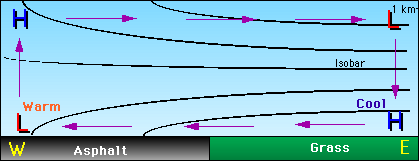Part 3:
Mesoscale
Mesoscale phenomena have an approximate size between 1km and 100 km and a time span between a few minutes to a day. This scale includes weather such as sea breezes and mountain-valley breezes. Air flow in this scale is influenced by differential heating or cooling over an area and by differences in terrain which can accentuate this process. We will look at these two factors and at a few examples of mesoscale flow.
Thermal circulations are wind patterns caused by differential heating, allowing locally cold air to sink and locally warm air to rise. The pattern is very simple. For example, let's say a surface that absorbs and emits radiation efficiently, such as a large asphalt parking lot, lies to the west, and a surface that absorbs and emits radiation poorly, such as a field of grass, lies to the east. Also, let's say that the isobars above the region are initially parallel. The air above the asphalt will warm quickly and expand, causing the distance between the isobars to increase. The air over the grass, however, does not warm as quickly and so the distance between the isobars does not increase as rapidly. Aloft (around 1 km up), a horizontal pressure gradient is created with higher pressure to the west and lower pressure to the east. Therefore, the PGF will force air to move aloft from the west to the east. At the surface, the air is removed from the west, creating a low pressure, and builds up in the east, creating a high pressure. This forms a loop, with warm air rising in the west, moving east, sinking to the surface high pressure area, and then moving along the surface to the west where the low pressure area sits. Click on the image below to view an animation of this cycle. Or, if you do not have a frames-compatible browser, you may follow this link to view the animation without frames.

The surface high and low pressure areas that form due to heating are known as a thermal high and a thermal low. These types of circulations are very shallow, usually extending upward to a maximum of 2 km. A good example of a thermal circulation is the sea-land breeze, covered in the next section.




Developed by
 The Shodor
Education Foundation, Inc.
The Shodor
Education Foundation, Inc.
Copyright © 1996

 The Shodor
Education Foundation, Inc.
The Shodor
Education Foundation, Inc.